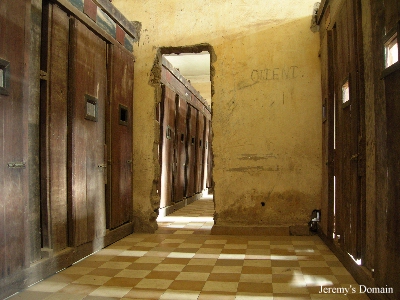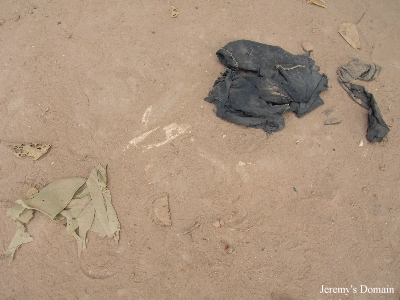
S-21 Tuol Sleng Genocide Museum
9th - 11th February 2006

Now, first things first. Phnom Penh's not exactly the most pleasant city to be wandering about. Scars of its horrific civil war and genocide of the 70s are still evident, and it's distinctly third world. But at the same time, you have a bustling city that's struggling to recover from the drastic Khmer Rouge regime. Put together, you have a city that's depressing, chaotic even, but never boring.
I'll start off with giving you a very brief summary of what happened under the Khmer Rouge regime as I think it's crucial for understanding why Cambodia is the way it is today. For a better idea of what happened, you can read David Chandler's Voices from S-21. The Khmer Rouge was the communist party that ruled Cambodia from 1975 to 1979. It is remembered mainly for causing the deaths of an estimated 1.5 million people through execution, starvation and forced labour. The Government under Pol Pot arrested, tortured and eventually executed anyone suspected of being an enemy. And from what I understand from reading Voices, confessions were oftentimes extracted under torture, and it often implicated friends and family of the supposed enemy. After four years of brutal rule, the Khmer Rouge regime was removed from power when Vietnam invaded Cambodia.
With that out of the way, let the story begin.
My mum and I arrived in Phnom Penh around lunch time after a six-hour bus journey from Siem Reap. If you're wondering, the journey's relatively comfortable as the road between Phnom Penh and Siem Reap's been paved. The moment the bus came to a stop at its terminal in Phnom Penh, we were instantly surrounded by a flock of eager drivers recommending every single guesthouse under the sun. We had made a reservation for a room at Dara Reang Sey Hotel near Sisovath Quay and we got a driver to bring us there.
After putting down our bags, we went to grab lunch. By then, it was already mid-afternoon. After lunch, we headed to the Tuol Sleng Genocide Museum, or otherwise known as S-21.
The site was formerly a high school that was used by the Khmer Rouge as its security prison. At that time, the buildings were enclosed in electrified barb wire, the classrooms partitioned into tiny prison and torture chambers, and all the windows were covered in iron bars and barb wire to prevent the prisoners from escaping.
Today, the site is largely preserved as it was when the Khmer Rouge were driven from power. Some rooms, as you can see in the picture above, contain only a rusting iron bedframe. Others have been partitioned into crude cells, as you can see in the picture below. On the patterned floor, dried blood stains are still visible. The Khmer Rouge had been extremely meticulous in their record keeping, and in S-21, you'll also find black-and-white pictures of the victims. Overall, a profoundly depressing place. Interestingly but not unsurprisingly, the only picture of Pol Pot had been defaced beyond recognition.

Cells inside S-21
After the sombre experience in S-21, we decided to head to the Russian Market. The bustling market is said to be the best traditional market for souvenirs, fake goods and pirated DVDs, but it's been a long day, and my mum didn't want to wander through the sprawling labyrinth of stalls. So we took a quick walk through the market and left the place. We headed to Phnom Penh's first and only shopping mall, Sorya, which is near the Central Market. Interestingly, the mall had instructors to teach locals how to use the escalators. There's also a food court and some Western-style fast food restaurants. We decided to spend the rest of the night here before heading back to the hotel.

The next morning, we decided to go to the Royal Palace after breakfast. To get there, we walked along Sisowath Quay, which is an attractive riverfront promenade. On the one side of the river, you have lots of shops and cafes, and on the other bank, across the Tonle Sap river, everything's quiet and relatively undeveloped. Soon we arrived at the Royal Palace.
It reminds me of the Grand Palace in Bangkok, but with much lesser crowd. This means you'll get to enjoy the place to yourself, unlike in Bangkok, where it's almost impossible to get a picture without anyone else in the frame. Well, there are a couple of buildings in there. The most interesting would have to be the Throne Hall. However, pictures are forbidden inside the hall so you'll just have to believe me when I say that the interior is very lavish.
Adjoining the Royal Palace via a side gate is the Silver Pagoda. I had imagined that the pagoda would be a tall, tiered tower, but it's not the case here. Instead, the Silver Pagoda is somewhat similar in structure to the Throne Hall, which you can see in the picture below. The pagoda is named for the 5000 silver tiles which are used to pave the floor, and it's really quite beautiful. Again, no pictures of the interior are allowed.

After leaving the Palace, we walked over to the Independence Monument, which is nearby. The large, reddish-brown monument was built in 1958 to celebrate independence, and as a memorial to Cambodia's war dead. From here, we took a tuk-tuk to the Central Market. This market has a very unique architecture. It is an ochre-coloured Art Deco building with four wings, and I think it sells almost anything under the sun. Under the central dome, you'll find gold and watch merchants, and as you wander out along the wings, you'll find electronics, as well as clothing and household goods. And in the area immediately outside the market, there are food stalls, as well as stalls selling souvenirs and flowers.

After strolling through the market, we decided to walk over to Sorya Mall for lunch. After lunch, we decided to stroll over to Wat Phnom, the hill which gave Phnom Penh its name. Apparently the area was a little dodgy in the past, but it seems okay now, except for a couple of beggars who pretty much left us alone. The hill is at the centre of a roundabout, and a not-too-long staircase leads to a temple at the top. In fact, calling this a hill is a bit of a stretch, but since it's called a hill, a hill it shall be.
After checking out the temple, we decided to walk down by another route, which took us past a giant clock built into the hillside. At this point, it was only around 2pm. I haven't planned on going to the Killing Fields at Choeung Ek but since it was still early, I decided we might as well visit the place. But first, we decided to head back to our hotel for a short break first.

After resting a while, we hired a tuk-tuk to bring us to the Killing Fields. It is situated about 15km from Phnom Penh, and more than 15,000 people were believed to have been murdered here. And although it is the most famous Killing Field, it is just one of many which dot the country. The ride there was rough and butt-numbing. Halfway into the journey, the driver turned off the paved road into a dirt track full of potholes. As such, the journey there took longer than expected.
So what do the Killing Fields look like today? Well, actually it's a series of shallow ditches about two to three feet deep, and in the distance, you'll see paddy fields, and cattle grazing. Given its gruesome history, the place is strangely serene. But if you look closer, you'll find some bones and rags still protruding from the paths around the mass graves. There's even a killing tree against which children were beaten to death. At this point, I'm finding it really hard to continue typing, so I shan't say more. It's impossible to make sense out of this senseless tragedy. One can only hope that history doesn't repeat itself.

Choeung Ek Killing Fields
With heavy hearts, we headed back to Phnom Penh to retire for the night. The next morning, we headed to the airport to board a flight to Bangkok.